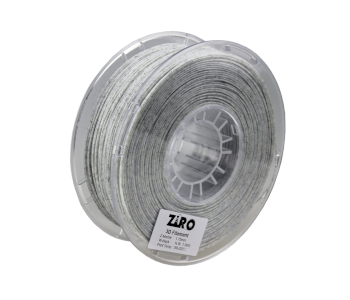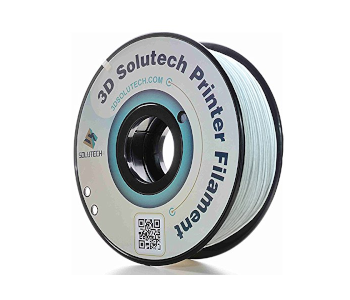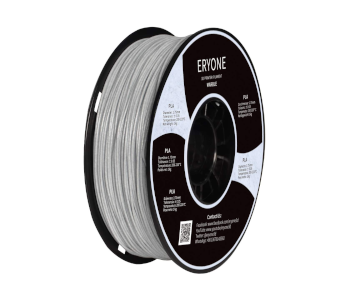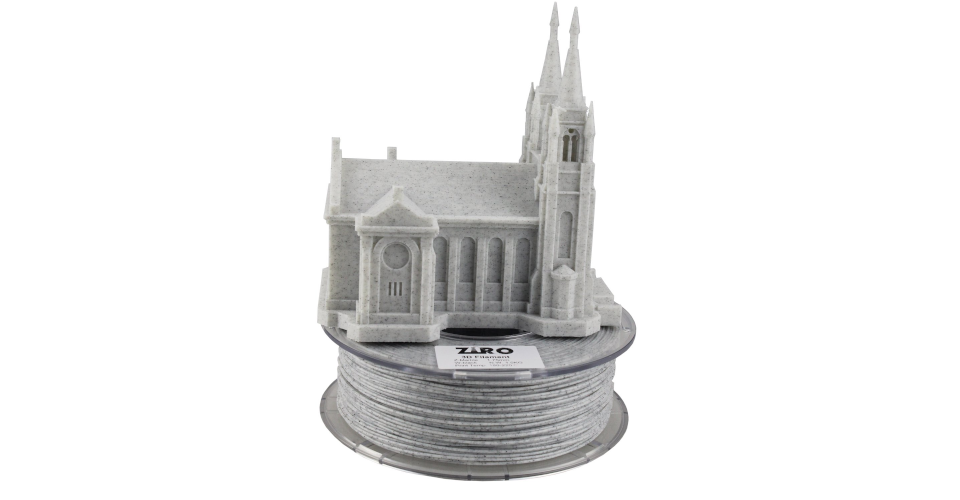Marble PLA Filament: Properties, How It’s Used, and Best Brands
One of the best things about 3D printing using FDM technology is the sheer volume of the selection of plastic filaments that you can choose from. And while printing with good old ABS or PLA is still fun, the whole “plastic” look of the prints can get old after a while.
In this article, we take a detailed look at another of the more unusual 3D printing filaments: Marble PLA. How well does the filament achieve the marble-like look? What special considerations need to be made when printing with Marble PLA and what are the best brands to buy if you want to try it out?
What is Marble PLA, and does it really look like marble?
Marble PLA is made with particles of powdered marble embedded in a PLA matrix. The choice of PLA as the plastic component is a common characteristic between almost all composite filaments, such as wood or bronze. This is primarily because of the ease with which PLA prints and its low printing temperature, which should reduce the chances of the solid component burning.
Filaments that mimic the appearance of common construction materials aren’t really anything new. We’ve already seen the likes of filaments with suspended wood, sandstone, or clay particles. The main difference with Marble PLA is that the source material – marble – doesn’t have a grainy appearance. Instead, the distinct characteristic of marble is the presence of colored swirls and veins created by mineral impurities. The contrast of these colored veins with the pure white carbonate-based rock matrix is what makes marble a very dynamic, yet elegant, building material.
One look at a strand of Marble PLA filament and you know that there’s no way it can recreate the natural swirls and veins of real marble. Instead, what you get is a mostly grayish-white print with randomly distributed dark specks. The best way to describe it would be that it looks closer to Stracciatella ice cream than marble. While the effect is still interesting and quite striking, to say that it looks like marble would be a stretch.
Despite not being able to simulate the appearance of the original material, the irregular pattern created by the specks of marble in the filament does a great job of giving 3D prints some character. Marble PLA is great for display pieces. If you want a 3D printed reproduction of a famous sculpture in your living room, then you should totally print it with Marble PLA. The dark specks actually do a great job of hiding layer lines, but you can readily sand and polish your Marble PLA print to take its visual appeal to the next level.
How to print with Marble PLA
There aren’t many Marble PLA filaments in the market today, but there may still be some variation in the recommended printer settings from one product to another. When in doubt, it’s best to follow to recommendations of your filament’s manufacturer.
Marble PLA prints at a forgiving extruder temperature range of 190 to 220 °C. Marble is very resistant to heat, so you don’t need to worry about burning the solid particles if you set the temperature too high.
PLA may not require a heated bed, but the presence of solid marble particles in the PLA matrix makes bed adhesion a little more challenging. The recommended bed temperature may vary depending on your Marble PLA filament, but we’ve seen settings range from 50 to 100 °C. In any case, you will want to apply a layer of heat-stable adhesive such as Kapton tape or hairspray.
Layer to layer adhesion is normally very good, so you can print at a rate of 40 to 70 millimeters per second. You might have to try setting the print speed to as low as possible then increase it incrementally as long as you don’t run into any stringing problems.
You can run a cooling fan at 100% setting but only after the first three layers have been printed to avoid bed adhesion problems. The rapid cooling should help the filament develop rigidity faster, which can help in preserving details in more intricate models. However, watch out for the effects of cooling on the layer to layer adhesion. If you experience layers falling apart, then it might better to do without any cooling for the whole printing duration.
Much like standard PLA, you can get good results post-processing Marble PLA with some sanding and polishing. The texture of Marble PLA helps to hide the layer lines that are inherent to FDM printing, so you might not even need to do a lot of sanding. Application of a polishing compound and additional sanding, however, would still be needed to give your finished print a characteristic sheen.
Pros and cons of Marble PLA
Marble PLA isn’t the type of filament that you would use because of how structurally stable it is or how well it lasts under challenging conditions. Marble PLA prints look good – that’s the best reason to use it. Given that fact, here are the other benefits of using Marble PLA and the challenges that you may encounter.
PROS
1. Not as abrasive
Abrasive solid components have always been a problem with composite filaments, making it necessary for the stock nozzle of 3D printers to be replaced with a pure metal alternative. This isn’t as big of a concern with Marble PLA, although you may still need to use a nozzle with a wide diameter to achieve a consistent flow of filament. We suggest using a 4-millimeter nozzle or bigger.
2. Easy to work with
Due to the choice of PLA as the plastic material, Marble PLA is a very easy material to work with. It only needs a low printing temperature, bed temperature, and basic bed adhesion. It’s not prone to warping and has very good layer adhesion. After your print is done, you should have minimal difficulty in removing it from the print bed. In many aspects, Marble PLA is a very friendly filament even for beginners.
3. Visually appealing
Yes, we’ve said it several times already, but the reason why anybody would print with Marble PLA is that it simply looks great. It may not look exactly like marble, but a Marble PLA print would surely stand out as a design piece in your living room. It’s an excellent showcase of the possibilities of 3D printing, and the results are well worth the effort.
CONS
1. Prone to stringing
The solid particles in Marble PLA may not be as abrasive as those of other composite filaments, but they still make it hard for the nozzle to create a suction seal. This means that stringing could still be a problem with Marble PLA, especially when the model you’re working on requires the print head to move huge distances without extrusion. To avoid this problem, you might need to reduce your printing speed settings.
2. Less durable than pure PLA
PLA isn’t the toughest filament material, but it had the benefit of being an almost pure material that can form bonds at the molecular level. The presence of solid materials in Marble PLA disrupts this property, resulting in a print that is overall less robust. For this reason, we wouldn’t recommend using Marble PLA for any application which will require it to withstand frequent or excessive mechanical stress.
3. Doesn’t look like marble
Marble PLA looks great, but if you’re looking for 3D prints that look like real marble, then you will be disappointed. There’s a certain flow and rhythm to the ‘imperfections’ of real marble that only natural processes can create. 3D printing hasn’t quite evolved to a level that can simulate natural phenomena, and we don’t know if it will ever get there.
Top 3 best brands of Marble PLA
There aren’t a lot of options right now if you’re looking for Marble PLA, but we’re happy to report that what little selection is out there has very good offerings. Aside from quality and consistency that are above expectations, Marble PLA also isn’t very expensive. You should be able to get a 1-kilogram roll for $30 or less. This price tag makes Marble PLA an even more worthwhile filament for beginners to try out.
1. ZIRO Marble Color 3D Printer Filament

By far, the most popular Marble PLA filament available today is this one from ZIRO. This 1.75-millimeter diameter filament has been made with strict production standards, so ZIRO can assure that you that its size remains consistent all throughout. The “marbling” pattern looks great and hides any imperfections from the printing process.
Getting the temperature right for the ZIRO Marble PLA can be quite challenging, but we find that common with many other composite filaments. You will want to print at the high end of the recommended temperature range. Once you have a good temperature and speed combination, this Marble PLA prints like butter.
2. 3D Solutech Marble PLA Filament

Popular brand 3D Solutech also sells their own Marble PLA filament. This professional filament manufacturer has been in the game for quite some time, so we can be sure that the quality of this filament is up to par.
This Marble PLA filament comes with recommendations for printer settings, which happen to work perfectly based on customer feedback. Again, getting the right settings with Marble PLA should result in a perfect printing experience with no stringing or warping whatsoever.
We’re docking a few points form the 3D Solutech Marple PLA because the white component of the “marble” looks less white and leans more towards gray. Thus, the black specks don’t really stand out all that well because of the reduced contrast. It still looks great, though, and some people may find that they prefer this more desaturated look.
3. Eryone Marble PLA Filament

Rounding up this list is this entry from the relatively lesser known brand, Eryone. Despite not being a household name in the 3D printing world, this product has proven to be one of the most popular Marble PLA filaments.
In terms of looks, the Eryone Marble PLA filament may be a worthy rival of its ZIRO counterpart. Finished prints look great, accentuated by the fact that this Marble PLA prints cleanly with little stringing or blobs. Granted that getting that “sweet spot” isn’t going to be easy – you could end up spending a few hours getting the settings just right, which could depend on the peculiarities of your specific 3D printer.
The roundup
| Material | Marble PLA (marble powder in PLA matrix) |
| Properties | Excellent visual appeal, not likely to warp, less durable than PLA, brittle filament, prone to stringing |
| Applications | Design pieces |
| Printing temperature | 190 to 220 °C |
| Bed temperature | 50 to 100 °C |
| Bed adhesion | Kapton tape or hairspray |
| Printing speed | 40 to 70 millimeters per second |
| Cooling | No cooling for the first three layers; 100% cooling for all successive layers |
There’s a certain novelty with Marble PLA which makes it a very intriguing filament to try out. Few of us can even imagine making something with real marble, so the possibility of making your own sculpture with a material that even barely resembles marble is already a compelling proposition.
Marble PLA doesn’t exactly do a very good job of mimicking what real marble looks like. It’s been often described as looking more like cookies and cream than marble. That description doesn’t sound all that bad either. If you haven’t tried printing with composite filaments before, then we recommend forking over $30 for a spool of Marble PLA.



“We suggest using a 4-millimeter nozzle or bigger.”
I think you mean 0.4mm nozzle? 4mm is huge!